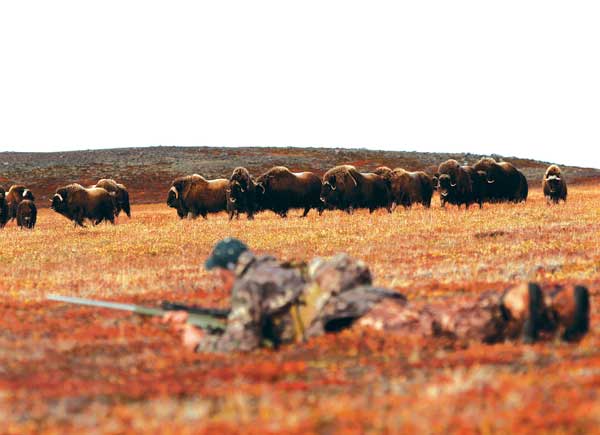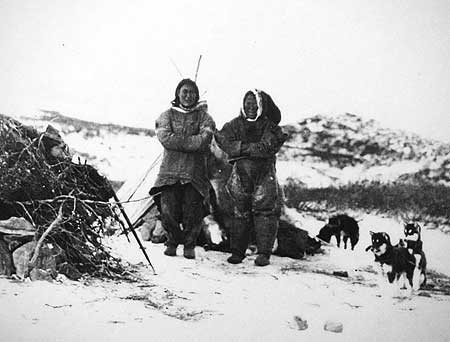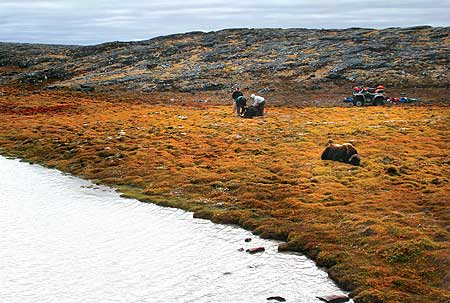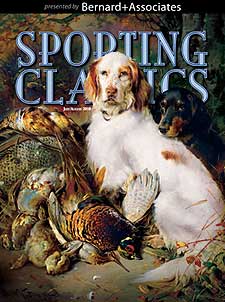Hunting Oxen of the Ice Cap
By Ron Spomer
Presented by Bernard+Associates


Columbia, SC –-(AmmoLand.com)- Shaggy, hump-backed remnants of the Pleistocene, musk ox are flourishing on the Arctic tundra. There were no polar bears, and no minus-60 degree temperatures. But there were musk oxen.
“On the bluff across the river,” our camp cook said, pointing. He was the first person awake in our tundra camp high above the Arctic Circle in Nunavut, one of the new provinces carved out of Canada’s Northwest Territories. “Probably an old bull all by itself. Just off that point. See?”
“Oh yeah!” Three veteran U.S. hunters eyeballed their first wild musk ox, one of most recognized yet least seen and least appreciated big game animals in North America.
Two of us hopped into an aluminum boat with George Hagonak, one of our Inuit guides, and motored across the wide, milky Ellice River.
“Both horns are broken off,” I said after a careful study through binoculars. The others confirmed it, despite the dim, gray dawn light.
“He’s an outcast,” George explained. “Lost his standing when he lost his weapons. The younger bulls have taken over the herd.”
That herd was nowhere to be seen, so we lost interest, too, no one willing to spend his tag on a broken bull the first morning of a hunt we’d traveled two days and thousands of miles to make.
Musk oxen, umingmak (the bearded one) in the native tongue, are uncommonly hunted because they are tailored to live where few humans care to go – the extreme northern edge of North America, hard against the Beaufort Sea a few hundred miles south of polar ice. To reach this land one must fly in ever smaller planes from the U.S. to Edmonton, then to Yellow Knife, Kugluktuk, Ikaluktutiak (Cambridge Bay on Victoria Island), and finally, back across the Queen Maude Gulf to a canvas and plywood camp on the naked banks of the Ellice River a few miles from the salt bay into which it empties.

Here, George’s hardy, creative ancestors lived for centuries with stone age technology, using rocks, plant fibers, animal bones and skins to create the tools necessary for surviving nearly nine months of winter and temperatures plummeting more than 50 degrees below zero. George and his family continue some of the old ways in summer camp, putting up Arctic char, lake trout, caribou and umingmak for the winter. Instead of kayaks and dog sleds, however, they use aluminum boats and four-wheelers.
“I think a dog sled would be more efficient and less painful,” I whined after our first day’s search. We’d motored and hiked nearly 30 miles over lumpy, bumpy, squishy muskeg tundra, finding one musk ox, four caribou, many ptarmigan and geese, and one rare tundra grizzly sow with two cubs. Despite low-pressure tires, shock absorbers and deeply padded seats, the trip could only be described as bone-jarring. And noisy. You truly cannot appreciate any environment under the assault of an infernal combustion engine.
“No wonder your people did their hunting in winter,” I remarked.
“No doubt. In summer about all they hunted were waterfowl eggs and flightless geese,” George answered, gesturing across an endless vista of yellow grass, blue lakes and bedrock ridges. “I don’t think they got far from camp. They were drying fish for the dogs. They didn’t go after caribou and musk ox until they could sled over the snow.”
Barren, harsh, unforgiving and brutal are a few adjectives that accurately describe the Arctic tundra. The land is flat to rolling, with intermittent ridges of exposed bedrock. Its soils are damp to submerged, despite annual precipitation of just seven inches. Permafrost holds runoff near the surface where a three-month summer is too short and cool to evaporate it all. Still, many of the lakes shrink or dry up completely, just as they do in North Dakota. And like North Dakota’s glacial pothole country, the Ellice River uplands, protected as the Queen Maude Bird Refuge, are a waterfowl nesting paradise, largely free of egg-eating predators like raccoons, possums, skunks and badgers. A few Arctic fox make a living here, but after the birds migrate south, winter ruthlessly winnows the puppy population.
Musk oxen can’t fly south, so they hide from the cold beneath haystacks of hair and wool. Guard hairs two feet long drape over dense qiviut, the mammalian equivalent of eider down. It’s the lightest, most efficient wool known to man. The animals brush away light snow with their noses and paw with hoofs to expose vegetation rarely as tall as their knees. Alas, hair is a poor defense against wolf fangs, polar bear claws or bullets.
“The one with the longest horns is subdominant?” my hunting partner Linda Powell asked. We lay atop a ridge with our guides, George and Jack, studying nine musk oxen 400 yards across a stream valley. One shaggy bull tried sidling up to the seven cows while another chased him off. Repeatedly. Had the youngster chosen to challenge, we would have seen a clash of horns akin to a bighorn sheep battle.
“Yeah. The one running him off must be a year or two older. But his horns are worn down more at the tips,” I explained. They were supposed to be taller and wider at the base, or boss, but we had trouble discerning this, even with the spotting scope at 60X. We could see more ridges and wrinkles on the older animal’s boss, a sure sign of age.
“There’s more hair between the bosses on the younger bull.” Linda observed. “George told me that’s another way to age them.”
We watched the August mating ritual play out for nearly a half-hour until the lead cow caught our scent on the 15-mph wind. Her head went up and turned toward us. She stared a few seconds as if hoping for visual confirmation. Whether she could see us lying there beside broken boulders remains moot. She turned and led the entire herd over the far skyline. We hadn’t expected that.
“So much for dumb musk ox. Can we go after them?” I asked.
“We’ll have to find a way across the stream,” Jack said. “Hop on.” We mounted our rubber-shod steeds and rumbled along the tundra waterway, nary a tree or even a respectable willow shrub in sight. We crossed at a riffle, the water climbing halfway up the knobby tires, then parked at the base of the ridge. When we peeked over the top, the game was gone. We hadn’t expected that, either.
Finding musk oxen is actually easier now than it was 30, 60, even 100 years ago. The species’ ancient tactic of forming a defensive circle against wolves was no match for spears, arrows or firearms. An Alaska population near Wainwright was exterminated by 1865. Admiral Perry’s expedition to the North Pole accounted for some 600 early in the 20th century. Since then the herds have been reintroduced, protected and nurtured. Now, under careful harvest regimens, they flourish.
Frank Analok, an Inuit elder in Cambridge Bay, was quoted as saying “. . . there was never a time when there were so many musk oxen. Now they’re all over the land, by the seashore, to the west, just everywhere. It was never like that when I was young.” It’s like that today.
“There they are. Way out on that flat. By the water.” The last cow and young bull in our herd were disappearing around another of those bedrock outcroppings. We hiked a half-mile, climbed a higher ridge and spotted all nine musk ox strung single file, now two miles away and still moving.
“Looks like they’re going to cross all the way to those far ridges, doesn’t it,” Linda said.
“Yeah, and we’re going to get soaked chasing after them.” Water sparkled here and there amid yellow grasses and sedges over the entire basin.
“We’ll wait here and watch where they go.”
Good thing we did because the beasts turned from their route and slipped between two ridges, disappearing through what proved to be a shallow notch opening onto more lakes, wet meadows and sedge basins. Water sprayed from the wheels as our guides turned and churned and backtracked and picked their way across. Twice we got stuck, nose first in small bogs.
“The four-wheeler buddy system,” Linda noted as one machine pulled the other free.
We stopped for lunch at the first dry spot, then grabbed our binoculars and rifles and climbed high to reconnoiter. Our quarry had gathered atop a stony ridge where the wind kept insects at bay. Several cows lay chewing their cud. The old bull stood close beside a cow, laying his chin on her back. This was the one Linda would target. I’d try for his young competitor now circling the harem at a respectable distance.

Eons ago, when the northern ice cap oozed as far south as Nebraska and Illinois, musk oxen must have been more common, grazing side by side with wooly mammoths, perhaps, or Irish elk in Europe. They must have formed their defensive circles and thrown their hooked horns at dire wolves and saber-toothed cats. Maybe they watched alertly as giant cave bears lumbered by. Why they survived while so many Pleistocene mammals died out remains a mystery. Even their taxonomy remains clouded. Some consider them closely allied with bison, others with sheep. The short-necked, hump-shoulder body reflects bison, but three inches of pneumatic skull bone beneath the horn echoes sheep anatomy. Indeed, when bulls come to blows over their place in the pecking order, they run at one another from a considerable distance, landing horn-to-horn at nearly 25 mph. If this doesn’t settle the issue, they may indulge in bison-like shoving and hooking. With older bulls approaching 900 pounds total mass, these exercises can literally be earth-shaking.
The bulls we were stalking must have settled the dominance question much earlier. The longer-horned but younger bull maintained sufficient distance, yet continued pestering the herd boss, and that diversion aided our stalk.
“We can get fairly close if we slip behind this ridge . . . walk right up to them.” Well, not quite. But within 500 yards. Then we began to crawl, keeping large, frost-heaved boulders between ourselves and the herd, dropping into shallow, grassy ditches created by eons of freezing, thawing and runoff. The wind was in our faces.
“Freeze! They’re looking. That one cow is looking right at us.” She stared nearly five minutes before another altercation between the bulls distracted her. The master was again chasing the youngster from the forbidden city.
“Get to that ledge and we can shoot from it. Should be less than 200 yards.” I pointed to a box-like projection of rock near the far edge of our ridge.
“Let’s do it while they’re occupied,” Linda said, and we crawled again, fast until we fetched up against the wall.
“Can you shoot from there? I can lay over this one down here.”
“I’m good. What’s the range?”
I popped the lid from my rangefinder and punched it. “One-sixty-five to your bull. Mine’s at two-twenty. That’s about dead-on for the way I’m sighted.” I hadn’t anticipated shooting at that distance, imagining the dumb brutes would let us walk right up. How wary could a musk ox be? Pretty wary, as these were proving. The bunch began moving off the far side of their ridge.
“The lead cow is suspicious,” George said from behind us. “She’s going to leave. You’d better shoot if you’re going to shoot.”
I chambered a round. “Any time you’re ready, Linda. I’ll shoot right after you.” And I did. Poorly, putting the 160-grain bullet too far back. Both bulls rumbled downhill, coming closer. We each shot again and they fell in a little basin beside a tundra lake. But the cows kept coming, thundering right at us, throwing mud and grass from the muskeg, long, black hairs bouncing and blowing in the wind. I dropped my rifle and grabbed the camera in time to capture the galloping herd before it turned and disappeared over the ridge. Hump-shouldered and heavy, an enduring remnant of the Pleistocene. Still here.

GEARING UP
Arctic weather on the Queen Maude Gulf isn’t kind to wood or steel. To combat the wet, I carried a Remington M700 Alaskan Ti (Titanium) with fluted, 24-inch, stainless-steel barrel pillar bedded in a synthetic Bell & Carlson stock with its MaxxGuard finish that seems to “give” like a thin coating of rubber. It doesn’t slip when wet. Highly functional, as was the R3 recoil pad, which incorporates LimbSaver technology. The rig weighed just 6 ¼ pounds. A crisp Kahles scope and mounts added another pound. The rifle was chambered for the excellent, veteran 7mm Rem. Mag., still as potent as it was when it first took the hunting world by storm in 1962. Remington’s latest premier loading of a 160-grain Swift A-Frame makes the old seven Mag. deadlier than ever. Both bullets pushed right through the bull.
Optical chores were handled with aplomb by Swarovski’s petite 8×32 EL and 20-60X 65mm spotting scope. SureFire’s latest little flashlight, powered by a single 123A 3-volt Lithium battery, blasted across the tundra like a klieg light during nocturnal visits to the latrine. Unbelievable output from such a small torch. Reassuring in grizzly habitat.
While rubber hip boots are standard footwear on the tundra, they are also clammy and sometimes cold. Since I didn’t have to drag stuck 4-wheelers out of the swamps, I kept my feet comfortable, warm and dry in a pair of ten-inch high, Gore-Tex-lined, Creek boots by Lowa. Instant comfort, no break-in required, great support.
IF YOU WANT TO GO
Contact Canada North Outfitting by e-mail: cnonorth@istar.ca. or visit: canadanorthoutfitting.bigbluesky.ca.

About:
Sporting Classics is the magazine for discovering the best in hunting and fishing worldwide. Every page is carefully crafted, through word and picture, to transport you on an unforgettable journey into the great outdoors.
Travel to the best hunting and fishing destinations. Relive the finest outdoor stories from yesteryear. Discover classic firearms and fishing tackle by the most renowned craftsmen. Gain valuable knowledge from columns written by top experts in their fields: gundogs, shotguns, fly fishing, rifles, art and more.
From great fiction to modern-day adventures, every article is complemented by exciting photography and masterful paintings. This isn’t just another “how to” outdoor magazine. Come. Join us! Visit: www.sportingclassics.net
